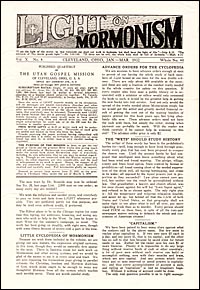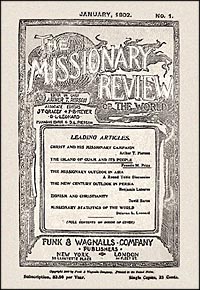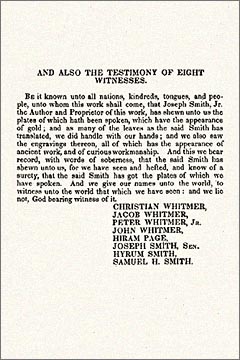
|
John Danforth Nutting (1854-1949) Publications (Ohio, early 1900s) Jan '27 Apr '27 Jan '28 Jul '29 Jul '30 Apr '31 |
 |
J. D. Nutting Papers | Christian Standard | Bays' 1897 Doctrines & Dogmas...
Shook's 1914 True Origin of Book of Mormon | 1900s R. B. Neal publications
 Vol. V. No. 4. Cleveland, Ohio. Jan.-Mar., 1927 Whole No. 20.  [p. 159] |
 Vol. VI. No. 1. Cleveland, Ohio. Apr.-June, 1927 Whole No. 21.  [p. 165] |
 Vol. VI. No. 4. Cleveland, Ohio. Jan.-Mar., 1928 Whole No. 24.  [p. 185] |
 Vol. VIII. No. 2. Cleveland, Ohio. July-Sept., 1929 Whole No. 30.  [p. 238] |
 Vol. IX. No. 2. Cleveland, Ohio. July-Sept., 1930 Whole No. 34.  [p. 265] |
 Vol. X. No. 1. Cleveland, Ohio. Apr.-June, 1931 Whole No. 34.  [p. 294] |
|
John Danforth Nutting (1854-1949) Pamphlets and Articles |
 |
|
"Mormonism To-day"
|
|
Rev. John D. Nutting Bibliography Articles of Faith of the "Latter-Day Saints" NYC: League of Social Service, [1899?] What Congress can do about Roberts, Mormon Mendacity [no publication data, printed c. 1899] Some Extracts from Secret oaths & ceremonies of the Mormon Church [no publication data, printed c. 1899] The Truth About the Origin of the Book of Mormon. San Bernardino: Harry A. McGimsey; [1900] The New Effort in Behalf of Utah Cleveland, OH: Utah Gospel Mission; [1900] The Private Doctrines of Mormon theology Cleveland, OH: Utah Gospel Mission; [1900] The True Mormon Doctrine Cleveland, OH: Utah Gospel Mission; 1901 Greater Points of Christian Truth... by... student of... Mormonism Cleveland, OH: Utah Gospel Mission; 1901 A Journey Among the Mormons Cleveland, OH: Utah Gospel Mission; [1901] Mormonism Proclaiming Itself a Fraud Cleveland, OH: Utah Gospel Mission; [1901] Main Facts Regarding the Growth and Power of Mormonism Cleveland, OH: Utah Gospel Mission; [1902] The Story of a Mormon Convert Cleveland, OH: Utah Gospel Mission; 1903 Present Day Mormonism and its Remedy Cleveland, OH: Utah Gospel Mission; 1904 Religious Destitution in a "Christian Country" Cleveland, OH: Utah Gospel Mission; [1907] The Wonderful Story of the Wonderful Book Cleveland: Utah Gospel Mission series, no. 04; 1908 Why I could Never be a Mormon Cleveland, OH: Utah Gospel Mission; 1911 The Private Doctrines of Mormon Theology Cleveland: Utah Gospel Mission; 1912 The Secret oaths and Ceremonies of Mormonism Cleveland, OH: Utah Gospel Mission; [1912] Incidents and Anecdotes Illustrating Mormonism Cleveland, OH: Utah Gospel Mission; [1912? rep 1915] Mormonism To-Day and Its Remedy Cleveland, OH: Utah Gospel Mission; 1913 The Real Doctrines of Mormonism Cleveland, OH: Utah Gospel Mission; 1921 The Real Doctrines of Mormonism Cleveland, OH: Utah Gospel Mission; 1921 The Guard's Great Question Cleveland: Utah Gospel Mission; [pre-1922] The Truth About God Cleveland: Utah Gospel Mission; [pre-1922] Mormon Doctrine and Christian Truth Cleveland: Utah Gospel Mission; [pre-1922] Thoughts About Heaven Cleveland: Utah Gospel Mission; [pre-1922] Special Difficulties of Christian Work Among Mormons Cleveland, OH: Utah Gospel Mission; [pre-1922] Josephite or "Reorganized" Mormonism Cleveland: Utah Gospel Mission; [pre-1922] The Fraud of the "Inspired Translation" Cleveland, OH: Utah Gospel Mission; [pre-1922] Mormon Twistings of the Bible Cleveland, OH: Utah Gospel Mission; [pre-1922] Reorganized or Josephite Mormonism, Carefully Considered Cleveland, OH: Utah Gospel Mission; 1922 Paul's Method of Dealing with False Religionists Cleveland, OH: Utah Gospel Mission; [1927?] Teachings of Mormonism and Christianity Compared Cleveland: Utah Gospel Mission series, no. 10; [1928? rep 1931] The Road to Glory-Land Cleveland: Utah Gospel Mission series, no. 11 [1929? rep 1931] Why Care about Mormonism? Cleveland, OH: Utah Gospel Mission; [1931] What We do in the West Cleveland, OH: Utah Gospel Mission; [1931] Oliver Cowdery's Renunciation of Mormonism Cleveland, OH: Utah Gospel Mission; [pre-1932] Mormon Morals Cleveland, OH: Utah Gospel Mission; [pre-1932] The Truth About God Cleveland, OH: Utah Gospel Mission; [pre-1932] Who First Acknowledged Polygamy? Cleveland, OH: Utah Gospel Mission; [pre-1932] The Mormon's Mistake Cleveland, OH: Utah Gospel Mission; [pre-1932] How to Meet the Mormon Need and Danger Cleveland, OH: Utah Gospel Mission; [1937?] Eight Reasons why no one should be a Mormon Cleveland, OH: Utah Gospel Mission; [1939?] If not Much, then a Little! Cleveland, OH: Utah Gospel Mission; [1940?] Why? Cleveland, OH: Utah Gospel Mission; 1940 Some Soul-stirring Reasons for Knowing... Mormon Issue Cleveland, OH: Utah Gospel Mission; 1943 Contradictions in Mormon Books and Doctrines Cleveland, OH: Utah Gospel Mission; [1934? rep 1942] ----------------------------------- "The Mormons: A reply. To the editors of the Outlook" in: The Outlook v. 64, February 24, 1900, p. 467-470 "A Study of the Present Mormon Problems" in: The Independent v. 54, April 17, 1902, p. 924-930 "Awheel and Afoot in Mormondom..." in The Home Missionary vol. 74, no. 2, May 1905, p. 37-45 "Difficulties of Work Among the Mormons" in: Missionary Review of the World Vol. 26, 1903, p. 855-858 |
|
Transcriber's Comments
The Book of Clevelanders, A Biographical Dictionary of Living Men of the City of Cleveland, Burrows Book Company, 1914 (under construction) |
Back to top of this page
History Vault | Bookshelf | Spalding Library | Mormon Classics | Newspapers
HOME unOFFICIAL JOSEPH SMITH HOME PAGE CHRONOLOGY
last updated: May 6, 2006
